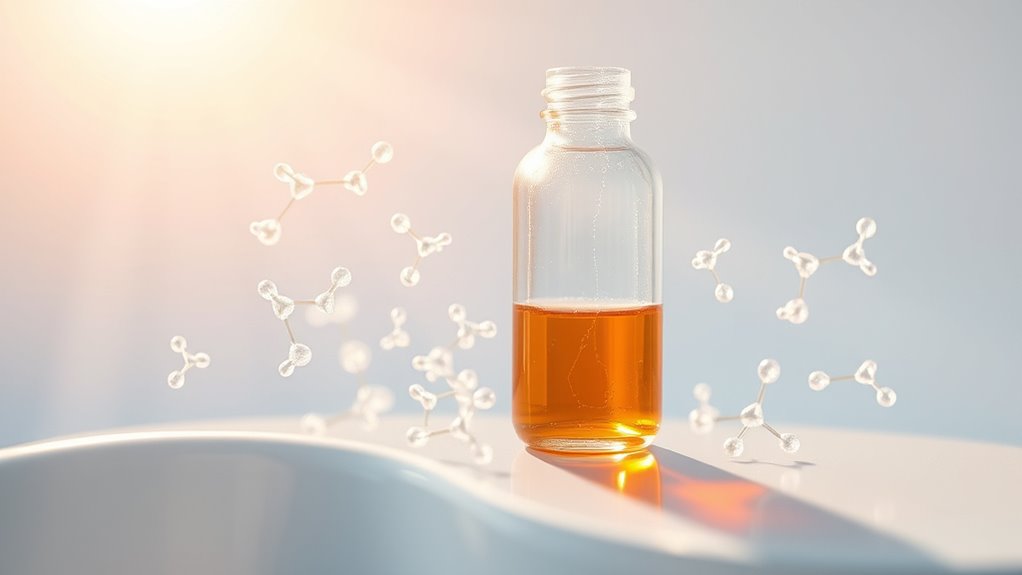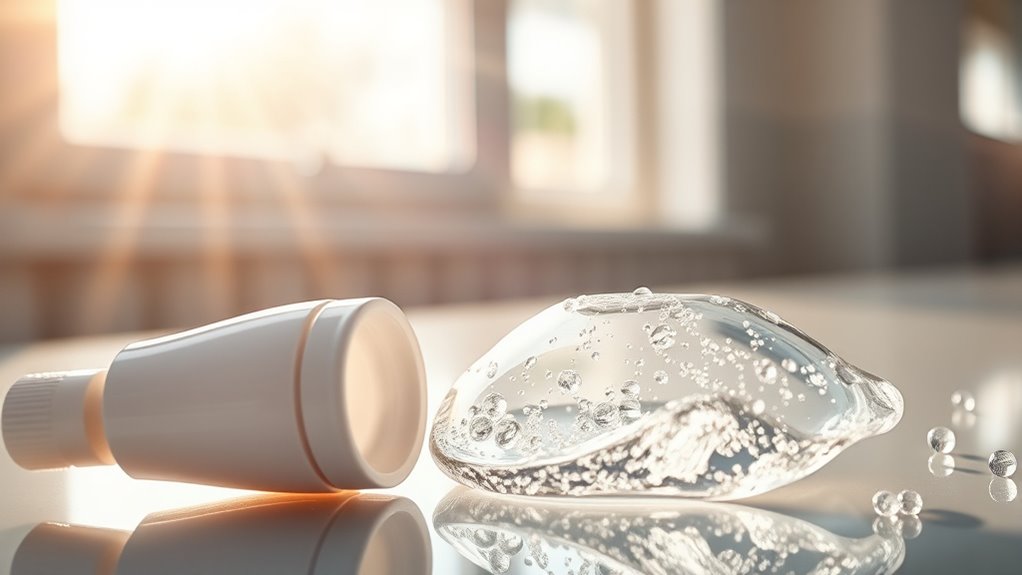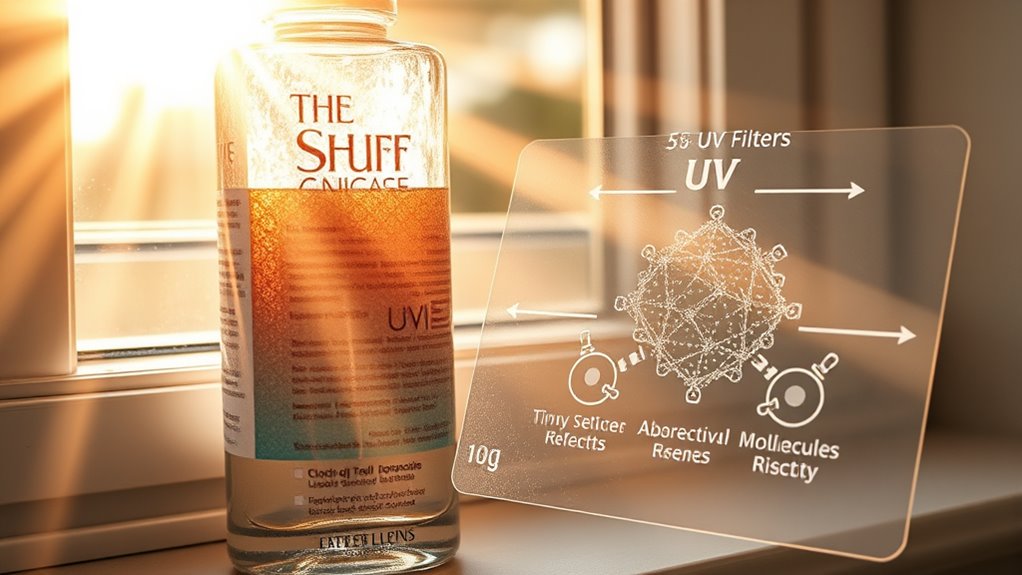Sunscreen works by using UV filters that either absorb or reflect harmful rays from the sun, protecting your skin. Chemical filters absorb UV radiation and convert it into heat, while mineral filters like zinc oxide reflect and scatter rays on the skin’s surface. Many sunscreens combine both for broad protection against UVA and UVB. To understand how these filters work and keep your skin safe, there’s more to discover if you keep exploring.
Key Takeaways
- Sunscreens contain chemical or mineral filters that block, absorb, or reflect UV rays to protect the skin.
- Organic (chemical) filters absorb UV radiation and convert it into heat or light, preventing skin damage.
- Physical (mineral) filters like zinc oxide and titanium dioxide reflect and scatter UV rays on the skin surface.
- Broad-spectrum sunscreens combine multiple filters to protect against both UVA and UVB rays.
- Proper application and environmental factors influence how effectively sunscreen shields the skin from UV damage.
Types of UV Filters in Sunscreens

Have you ever wondered how sunscreens protect your skin from harmful UV rays? The key lies in the different types of UV filters they contain.
Organic (chemical) UVB filters, like Octyl triazone and Octinoxate, mainly absorb UVB rays, preventing sunburn and DNA damage. They’re oil-soluble and blend well into lightweight formulas. These filters convert UV radiation into heat or light, reducing the amount reaching your skin.
UVA filters, such as Avobenzone and Ecamsule, absorb UVA rays that penetrate deeper, causing aging and long-term damage. Some filters, like Avobenzone, need stabilizers to stay effective under sunlight.
Many sunscreens combine multiple filters to offer broad-spectrum protection, covering both UVA and UVB rays.
While organic filters are effective, they’ve regulatory limits on their concentration and usage, ensuring safety and efficacy in your sunscreen.
How Physical (Mineral) Sunscreens Protect Your Skin

Physical (mineral) sunscreens protect your skin by forming a physical barrier that reflects and scatters UV rays away from the surface. They mainly contain titanium dioxide and zinc oxide, which are inorganic minerals that act like mirrors, bouncing UVA and UVB rays off your skin.
These minerals sit on the skin’s surface, providing immediate, broad-spectrum protection without needing time to absorb. Because they reflect and scatter sunlight, they reduce the amount of UV radiation penetrating your skin. The effectiveness of these minerals depends on their particle size and dispersion, which can influence their color accuracy and overall protective performance.
Zinc oxide and titanium dioxide can also absorb some UV rays, converting them into less harmful energy. This makes physical sunscreens a reliable choice for sensitive skin, as they’re less likely to cause irritation.
They’re also environmentally friendly and effective against the full spectrum of UV rays. Unlike chemical filters, physical sunscreens typically require fewer reapplications and are less likely to cause allergic reactions.
The Mechanism Behind Chemical (Organic) Sunscreens

Chemical (organic) sunscreens protect your skin by absorbing UV radiation through their organic compounds, which contain aromatic carbon structures and electron-dense bonds. When UV rays hit these molecules, electrons become excited and move to higher energy levels. This energy absorption causes the molecules to convert UV energy into heat through relaxation, reducing the amount of UV radiation reaching your skin. After releasing the heat, the molecules return to their ground state, ready to absorb more UV rays. The electronic transitions involved are governed by the molecules’ conjugated systems, which determine their absorption wavelengths. Compounds like oxybenzone, avobenzone, octocrylene, homosalate, and octinoxate each target different parts of the UV spectrum, providing broad protection. Their ability to absorb and dissipate UV energy efficiently helps prevent skin damage, sunburn, and premature aging, making chemical sunscreens effective for continuous UV defense.
The Role of Hybrid Formulations in Sun Protection

Hybrid formulations in sun protection combine both chemical and mineral UV filters to deliver thorough defense against UV radiation. By including zinc oxide or titanium dioxide, they reflect UV rays physically, providing an immediate shield.
Simultaneously, chemical filters like avobenzone or octinoxate absorb UV light and convert it into heat, neutralizing harmful rays. This layered approach ensures broad-spectrum coverage against UVA and UVB, reducing the risk of skin damage.
Hybrids also lower irritation risks compared to pure chemical sunscreens and improve stability by preventing chemical degradation. They tend to be water-resistant, ideal for active lifestyles.
These formulations are often suitable for sensitive skin, with lightweight textures that minimize white cast and are easier to reapply. Overall, hybrid sunscreens offer a balanced, effective, and skin-friendly solution for daily sun protection.
Continual monitoring of AI safety measures ensures that innovations in sun protection remain effective and safe for consumers.
Key Ingredients and Their Functions in Sunscreens

Have you ever wondered what ingredients make sunscreens effective? Key ingredients include chemical and mineral filters that protect your skin in different ways.
Chemical filters like oxybenzone and avobenzone absorb UV rays and convert them into heat, preventing them from penetrating your skin. Mineral filters such as zinc oxide and titanium dioxide work by reflecting and absorbing UV rays, creating a physical barrier.
Broad-spectrum protection often combines ingredients like zinc oxide and avobenzone to guard against both UVA and UVB rays.
Some ingredients, like octocrylene, stabilize other filters, enhancing the formula’s stability. However, environmental concerns have led to restrictions on ingredients like oxybenzone and octinoxate.
Factors That Influence Sunscreen Effectiveness

The effectiveness of sunscreen depends heavily on how you apply and use it. Using the right amount is vital; aim for about 2 mg/cm² for maximum protection. Rubbing the product can reduce its SPF by roughly 20%, so gentle application is better. Proper application techniques are essential for ensuring the sunscreen performs as intended. Dispenser type matters—pump bottles typically deliver more sunscreen than squeeze or roll-on options. If you dress shortly after applying, especially with a thick layer, your SPF protection might drop. Double application within 20 minutes can help guarantee proper coverage. Environmental factors also influence effectiveness: water, sand, and weather conditions like high UV levels or altitude can weaken protection. Proper application techniques and timing, combined with awareness of these influences, guarantee you get the full benefit of your sunscreen.
Environmental and Safety Considerations of UV Filters

As sunscreen use increases worldwide, UV filters inevitably make their way into aquatic environments through wastewater discharge and recreational water activities, where they can wash off your skin. Once in water, these chemicals are detected in sediments, aquatic animals, and even coral reefs, showing widespread distribution. The persistence of these chemicals raises concerns about long-term ecological impacts and the potential for bioaccumulation in marine food chains. Organic UV filters tend to bioaccumulate in marine and freshwater species, disrupting their physiological processes and health—corals are especially vulnerable, with evidence of bleaching caused by certain chemicals. The chemical properties of UV filters, like lipophilicity and photostability, influence their persistence and toxicity. Growing concerns have led to regulatory scrutiny and the development of “reef-safe” products. Balancing sun protection with environmental safety remains a challenge, emphasizing the need for sustainable alternatives and increased awareness.
Frequently Asked Questions
How Do UV Filters Affect Skin Penetration and Long-Term Safety?
You might wonder how UV filters impact skin penetration and long-term safety. UV filters are designed to stay on the skin’s surface, especially larger molecules and encapsulated forms, reducing absorption.
Encapsulation techniques further limit penetration, minimizing toxicological risks. Using physical filters like zinc oxide and careful formulation also helps.
Can Sunscreen Ingredients Cause Skin Allergies or Sensitivities?
Your skin’s health is under attack more than you think, and sunscreen ingredients can actually cause allergies or sensitivities. Chemical filters like oxybenzone often trigger reactions such as redness, itching, and swelling, especially if you have sensitive skin or allergies.
To protect yourself, opt for mineral sunscreens with zinc oxide or titanium dioxide, which are less likely to cause issues. Always check labels and consider patch testing if you’re prone to skin reactions.
Do All UV Filters Provide Equal Protection Against UVA and UVB?
Not all UV filters offer equal protection against UVA and UVB rays. Some, like zinc oxide and titanium dioxide, provide broad-spectrum coverage, protecting you from both types of radiation.
Others, mainly chemical filters, tend to focus on UVB, which causes sunburn, and offer limited UVA protection. To stay fully protected, look for sunscreens labeled “broad-spectrum,” which combine multiple filters to cover the full UV spectrum effectively.
How Do Nanoparticles in Mineral Sunscreens Impact Environmental Safety?
Like Pandora’s box, nanoparticles in mineral sunscreens open environmental concerns you should consider. They persist in ecosystems, bioaccumulate, and can produce reactive oxygen species harmful to aquatic life.
You mightn’t see the damage, but these tiny particles can threaten algae, fish, and coral reefs, disrupting ecosystems. While effective for UV protection, their environmental footprint raises questions about safety and regulation, urging you to stay informed.
Are There Natural or Mineral-Based Alternatives to Chemical UV Filters?
You wonder if natural or mineral-based options can replace chemical UV filters. You can try coconut or wheat germ oil, which offer some SPF and nourish your skin.
Mineral filters like zinc oxide and titanium dioxide physically block UV rays, providing broad-spectrum protection. These alternatives are often gentler on sensitive skin and better for the environment, making them great options if you’re seeking natural or mineral-based UV protection.
Conclusion
Think of your sunscreen as a shield of knights guarding your skin castle. Each UV filter is a brave soldier, either blocking harmful rays like a sturdy wall or deflecting them like shining armor. When you choose the right mix, they work together to keep your skin safe from the sun’s attack. So, armor up wisely, and enjoy your day outdoors knowing your defenses are strong and ready.









